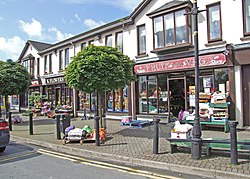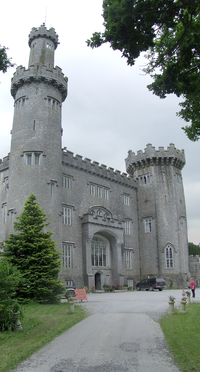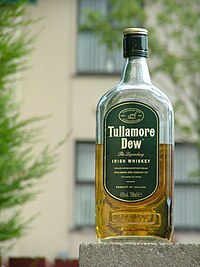Difference between revisions of "Tullamore"
m (clean up, typos fixed: therafter → thereafter) |
m (clean up) |
||
| Line 50: | Line 50: | ||
Just south of Tullamore are the unique '[[Lough Boora]]' parklands. The boglands are a landscape for a wide range of flora and fauna. The magnificent wetlands and wildlife wilderness of Lough Boora now host some of the most innovative land and environmental sculptures in Ireland. The artists, inspired by the rich natural and industrial legacy of the boglands, have created a series of large-scale sculptures that are now part of the environmental sculpture park Sculpture in the Parklands. | Just south of Tullamore are the unique '[[Lough Boora]]' parklands. The boglands are a landscape for a wide range of flora and fauna. The magnificent wetlands and wildlife wilderness of Lough Boora now host some of the most innovative land and environmental sculptures in Ireland. The artists, inspired by the rich natural and industrial legacy of the boglands, have created a series of large-scale sculptures that are now part of the environmental sculpture park Sculpture in the Parklands. | ||
| − | + | six miles west of Tullamore is the village of [[Rahan, County Offaly|Rahan]]. The remains of what was once a large monastery settlement founded by St Carthage or Mochuda in the 6th century, can be seen in the village. | |
Within 5 minutes' drive is the Celtic cross of [[Durrow, County Offaly|Durrow]]. In the middle of the 6th century a monastery was founded here by Saint Columba. The monastery is famous for an illuminated manuscript, written here in the 7th century, known as the Book of Durrow. | Within 5 minutes' drive is the Celtic cross of [[Durrow, County Offaly|Durrow]]. In the middle of the 6th century a monastery was founded here by Saint Columba. The monastery is famous for an illuminated manuscript, written here in the 7th century, known as the Book of Durrow. | ||
Latest revision as of 12:40, 2 August 2017
| Tullamore Irish: Tulach Mhór | |
| County Offaly | |
|---|---|
 Tullamore (near Bury Quai) | |
| Location | |
| Grid reference: | N335248 |
| Location: | 53°16’0"N, 7°30’0"W |
| Data | |
| Population: | 11,346 (2011) |
| Local Government | |
Tullamore is a town in County Offaly, in the midst of the Republic of Ireland. It is Offaly's county town and the centre of the county.
The name 'Tullamore' is from the Irish language Tulach Mhór, meaning "Great mound".
The Tullamore Show is held near the town every year.
The town's most famous export is Tullamore Dew - an Irish whiskey formerly distilled by Tullamore Distillery - that can be traced back to 1829. The distillery shut in the 1950s but its traces are still visible in the town. Tullamore Dew is now produced by William Grant & Sons in Midleton, County Cork, but the owners have announced plan to invest in a new pot still whiskey and malt whiskey distillery, bringing whiskey production back to the town.[1]
Contents
History
Tullamore was anciently in the territory of Firceall ruled by the O'Molloy clan, and part of the ancient Kingdom of Meath. Following the plantation of Offaly in the 16th and 17th centuries, Firceall was divided into the baronies of Eglish, Ballyboy & Ballycowen, with Tullamore located in Ballycowen.[2]
Tullamore was part of the first English plantation of Offaly in the 1570s. By the mid-1500s the lands that were originally ruled by the O'Molloy clan were securely "planted" and in the hands of the Moore family. From this point on a dynasty was established which endured into the late nineteenth century, commencing with the grant of the Tullamore area, comprising some 5000 acres, to Sir John Moore in 1622. At that time the Tullamore estate included a ruined castle, ten cottages and two water mills. Sir Robert Forth, who leased the lands from Thomas Moore (son and heir of Sir John), built a mansion house c.1641 in what is now the Charleville demesne. Charles Moore, Lord Tullamore, grandson of Thomas, eventually regained possession of the estate and when he died in 1674 it went via his sister to Charles William Bury. Charles William was later (1806) created the 1st Earl of Charleville in a second creation of the title.[3]
On 10 May 1785, the town was seriously damaged when the crash of a hot air balloon resulted in a fire that burned down as many as 130 homes, giving the town the distinction of being the location of the world's first known aviation disaster.[4] To this day, the town shield depicts a phoenix rising from the ashes. The event is yearly commemorated by the Phoenix festival which celebrates Tullamore's resurrection from the ashes following the accident.
The Grand Canal linked Tullamore to Dublin in 1798. During the Napoleonic Wars, a clash between troops of the King's German Legion and a regiment of British Light Infantry who were both stationed in the town, became known as the battle of Tullamore. Tullamore became county town of County Offaly in 1835, replacing Philipstown.
Culture
The Tullamore Phoenix Festival is an annual celebration of extreme, arts, culture and heritage was first held in August 2000. Thursday 17th to Sunday 20 July 2008. The festival holds many events including - Hot Air Balloons, Sky Diving, Live Outdoor Concerts, Street Entertainment, Fire Parade, Fireworks and much more.
The Queen of the Land Festival takes place in Tullamore each year on the third weekend in November. Primarily a personality contest it seeks to find the best examples of a modern Irish woman. It is organised by Offaly Macra Na Feirme. Each year about 25 girls between the age of 17 and 35 compete to be crowned Queen of the Land. The festival provides a host of entertainment throughout the town over the weekend, primarily at night.
An annual Tullamore Show takes place in August every year. It has grown considerably over the past number of years and is now the largest one day show in the country. It was cancelled in 07 and 08 due to heavy rain, though it did run again in 2009.[5]
Hugh Lynch's Pub on Kilbride Street has been operating as a public house since the early 1800s. In the early 1900s it was bought by the Williams Group, founders of the D.E. Williams Distillery, and run as a public bar and grocery, along with many other outlets in the Irish Midlands, from which they sold their growing whiskey brand “Tullamore Dew”. It has been in the Lynch Family since 1971 and attracts a mix of older and younger clients. One of the highlights every year is their outdoor festival where they put a roof over the street and provide 3 days of live free music.
The national Fleadh Ceoil was held in Tullamore for the very first time in August 2007. It returned in 2008, and returned for a third time from 21-23 Aug 2009.[6]
Places of interest
The Tullamore Dew Heritage Centre on the banks of the Grand Canal focuses on the distilling, canal and urban history of the town. Audio visual and self-guided tours are available daily.
Charleville Estate is located on the edge of the town. One of Ireland’s most splendid Gothic buildings, Charleville Castle, stands in this parkland setting which contains the King Oak, one of the biggest and oldest oak trees in the country. The oak woodland is botanically an important survivor of primeval stock. The park was the location of the annual Tullamore Agricultural Show into heavy rain caused two years' cancellations and movement thereafter to a drier location.
Tullamore is an ideal base for discovering the Slieve Bloom Mountains to the south of the county. The 'Slieve Bloom' mountains have many beautiful walking and cycling trails as well as excellent picnic areas with some panoramic views of the surrounding lowlands.
Just south of Tullamore are the unique 'Lough Boora' parklands. The boglands are a landscape for a wide range of flora and fauna. The magnificent wetlands and wildlife wilderness of Lough Boora now host some of the most innovative land and environmental sculptures in Ireland. The artists, inspired by the rich natural and industrial legacy of the boglands, have created a series of large-scale sculptures that are now part of the environmental sculpture park Sculpture in the Parklands.
six miles west of Tullamore is the village of Rahan. The remains of what was once a large monastery settlement founded by St Carthage or Mochuda in the 6th century, can be seen in the village.
Within 5 minutes' drive is the Celtic cross of Durrow. In the middle of the 6th century a monastery was founded here by Saint Columba. The monastery is famous for an illuminated manuscript, written here in the 7th century, known as the Book of Durrow.
Retail
The Bridge Centre, is the main shopping area in the town with a variety of shops. The Tullamore retail park on the Portarlington road also has a mix of shops including some of the big-chain stores.
Media
- Radio: Midlands 103
- Newspapers
- The Tullamore Tribune
- The Offaly Topic
Sport
- Athletics: Tullamore Harriers, founded in 1953.
- Football: Tullamore Town FC
- Gaelic Games: Tullamore GAA
- Rugby: Tullamore Rugby Club, founded in 1937
Pictures
Outside links
| ("Wikimedia Commons" has material about Tullamore) |
- Tullamore
- Hugh Lynch's Pub
- Tullamore Chamber
- Phoenix Festival
- Queen of the Land Festival
- Tullamore Life & Community
- Tullamore Dew Heritage Centre
- Tullamore news, sport and events
- Tullamore on line
- Architecture of Tullamore
References
- ↑ http://www.whiskymag.com/forum/viewtopic.php?t=14530
- ↑ http://www.omolloy.com/
- ↑ "Charleville Demesne & The Burys, 1600-1900". http://www.irishmidlandsancestry.com/content/offaly/community/charleville_demense.htm. Retrieved 2012-12-15.
- ↑ Byrne, Michael. The Tullamore Balloon Fire - First Air Disaster in History, Offaly Historical and Archaeological Society website, 9 January 2007 (retrieved 7 July 2011)
- ↑ "Tullamore Show cancelled for second year after downpours". Irish Independent. 11 August 2008. http://www.independent.ie/national-news/tullamore-show-cancelled-for-second-year-after-downpours-1451558.html.
- ↑ The 2009 Fleadh Ceoil






